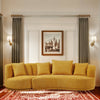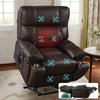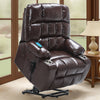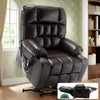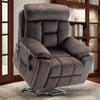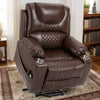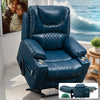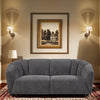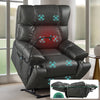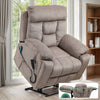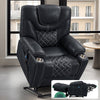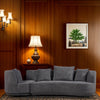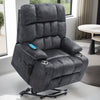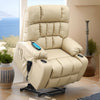The Essentials of Selecting a Nursery Chair
Understanding the Different Types of Nursery Chairs
When choosing a nursery chair, it's crucial to know your options. The most common types include:

- Gliders: Smooth, back-and-forth motion
- Rockers: Traditional rocking motion
- Recliners: Adjustable positions for comfort
- Swivel chairs: 360-degree rotation for flexibility
Each type offers unique benefits. Gliders provide a gentle, soothing motion that's perfect for naptime. Rockers offer a classic feel and often blend well with various decor styles. Recliners, including power lift recliners, offer multiple positions for feeding and relaxing. Swivel chairs allow easy movement and access to nearby items.
Consider your space, comfort needs, and personal preferences when selecting a chair type. Remember, the right chair can make a big difference in your nursery experience.
Criteria for Selecting the Right Chair for Your Nursery
When choosing a nursery chair, consider these key factors:
- Comfort: Look for ample cushioning and supportive backs.
- Size: Ensure it fits your nursery space and your body size.
- Durability: Choose materials that can withstand daily use and spills.
- Ease of cleaning: Opt for stain-resistant fabrics or removable covers.
- Noise level: Test for squeaks or creaks that might disturb your baby.
- Armrests: Wide, padded armrests provide comfort during long feeding sessions.
- Height: The chair should allow your feet to touch the ground comfortably.
- Extra features: Consider options like built-in USB ports or storage pockets.
Remember, a good nursery chair should serve you well beyond the infant stage. Choose a chair that will grow with your family and complement your home decor.
The Role of Comfort and Aesthetics in Nursery Chairs
Comfort is paramount when selecting a nursery chair. You'll spend countless hours in this chair, feeding, soothing, and bonding with your baby. Look for chairs with:
- Soft, plush upholstery
- Ergonomic design for proper back support
- Adjustable features for personalized comfort
Aesthetics are also important. Your nursery chair should:
- Complement your nursery's theme and color scheme
- Fit well with other furniture pieces
- Reflect your personal style
While comfort should be your top priority, don't compromise on style. Many modern nursery chairs offer both comfort and visual appeal. Consider neutral colors for longevity, or bold patterns for a statement piece. Remember, this chair will be a focal point in your nursery.
Navigating Safety and Regulations for Nursery Chairs
Key Safety Standards for Nursery Chairs in the United States
In the US, nursery chairs must meet specific safety standards. These include:

- Stability: Chairs should not tip over easily.
- Pinch points: Moving parts should not pose a risk to fingers or toes.
- Toxic materials: All materials used should be non-toxic and safe for babies.
- Fire resistance: Upholstery must meet flammability standards.
- Sharp edges: All edges and corners should be smooth and rounded.
The Consumer Product Safety Commission (CPSC) oversees these standards. They ensure that nursery furniture, including chairs, is safe for use. Always check for CPSC compliance when purchasing a nursery chair. This ensures your chair meets the highest safety standards.
Regulatory Compliance for Nursery Chairs Manufactured in the US
US-made nursery chairs must comply with strict regulations. These include:
- ASTM International standards for juvenile products
- CPSC guidelines for nursery furniture
- California's Proposition 65 for chemical exposure warnings
Manufacturers must test their products to ensure compliance. They should provide certification of adherence to these standards. When shopping, look for labels or documentation that prove compliance. This information is often found on product tags or in user manuals.
Remember, regulatory compliance is not just a legal requirement. It's a crucial aspect of ensuring your baby's safety in the nursery.
How to Ensure That Your Nursery Chair Meets Safety Standards
To ensure your nursery chair is safe, follow these steps:
- Check for safety certifications: Look for labels indicating JPMA or ASTM compliance.
- Research the brand: Choose reputable manufacturers known for safety standards.
- Read reviews: Look for feedback from other parents about safety and durability.
- Inspect the chair: Check for sturdy construction and smooth, rounded edges.
- Test the stability: Ensure the chair doesn't wobble or tip easily.
- Verify the locking mechanism: If it's a glider or recliner, test the locks.
- Check recall lists: Visit the CPSC website to see if the chair has been recalled.
- Follow assembly instructions: Incorrect assembly can compromise safety.
Don't hesitate to contact the manufacturer with any safety concerns. Remember, a safe nursery chair provides peace of mind, allowing you to focus on bonding with your baby.
Maximizing Space and Versatility in Your Nursery
Designing Your Nursery with Multipurpose Furniture
Maximizing space in your nursery is crucial, especially in smaller homes. Consider these tips:

- Choose dual-purpose furniture: Opt for a changing table that doubles as a dresser.
- Use vertical space: Install shelves or hanging organizers for storage.
- Select a crib with built-in storage: Some cribs have drawers underneath.
- Invest in a nursery chair with storage: Look for options with pockets or side tables.
- Use ottoman storage: Get an ottoman that opens for extra storage space.
When selecting furniture, think long-term. Choose pieces that can adapt as your child grows. A convertible crib that becomes a toddler bed is a great example. This approach saves money and space in the long run.
Remember, a well-designed nursery should be functional and comfortable for both baby and parents.
Space-Saving Solutions for Nursery Chairs
In smaller nurseries, every inch counts. Here are some space-saving chair options:
- Wall-hugging recliners: These need less space to fully recline.
- Compact gliders: Look for models designed for small spaces.
- Folding rocking chairs: These can be stored when not in use.
- Swivel chairs with a small footprint: They offer flexibility without taking up much room.
- Multifunctional chairs: Some chairs convert from rockers to stationary seats.
Consider the chair's placement carefully. Corners are often underutilized and perfect for a nursery chair. If space is really tight, a floor cushion or pouf can be a compact alternative for nursing sessions.
Remember, a space-saving chair doesn't mean sacrificing comfort. Many compact options still offer excellent support and comfort.
Adjustable and Adaptable Chairs for Growing Families
Investing in an adjustable chair can save money and space as your family grows. Look for:
- Chairs with removable cushions: These allow for easy cleaning and customization.
- Adjustable headrests: These accommodate different heights as your child grows.
- Convertible designs: Some chairs transform from rockers to stationary seats.
- Chairs with extendable footrests: These provide comfort for adults of different heights.
- Power lift recliners: These offer multiple positions and can assist with standing.
Consider how the chair will be used beyond the nursery stage. A well-chosen chair can move to other rooms as your child grows. This versatility ensures you get the most value from your purchase.
Remember, adaptability is key in nursery furniture. Choose pieces that grow with your family for long-term use and comfort.







